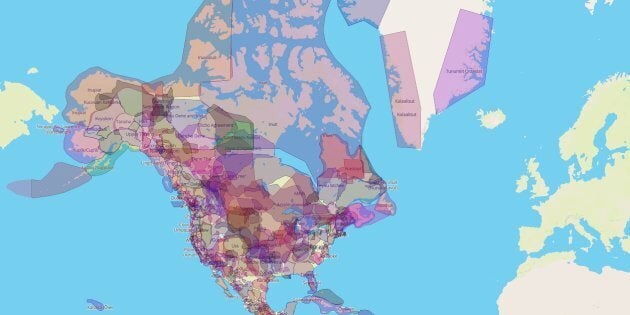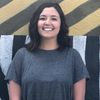
What traditional territory is your city on?
Are you on unceded xʷməθkwəy̓əm (Musqueam), Skwxwú7mesh (Squamish), and Səl̓ílwətaʔ/Selilwitulh (Tsleil-Waututh) territory? The territory of the Huron-Wendat and Petun First Nations, the Seneca and Mississaugas of the Credit River? Or unceded Abenaki/Abénaquis, Kanien’kehá:ka, Haudenosauneega (St Lawrence Iroquois), and Huron-Wendat territory?
If you don’t know, a website called Native Land can help answer the question for you.
The crowd-sourced, interactive website mapping traditional territories of Indigenous people, treaties and language has grown to become so much more, and has just become a Canadian not-for-profit.
Victor Temprano launched Native Land almost five years ago, while working on a pipeline-related website. He was researching resource development projects in British Columbia, and wanted to know which Indigenous territories these projects were taking place on.

His company, Mapster is his full-time job, and Native Land became more of a side passion project, which is one of the reasons crowdsourcing the information is so important to him.
“I can’t put in the time I would if it was a full-time job,” said Temperano. “Canada has so many nations, and we’re expanding all over the world, that it’s a lot of research to do.”
Native Land’s territory boundaries started with Canada, but now cover other parts of the world: Australia, New Zealand, parts of South America, Central America, the Caribbean.
“If you’re not familiar with certain parts of the world, you might totally misunderstand what Indigeneity is in different parts of the world, so it’s impossible to tackle this as one person,” said Temperano.
Temperano is also a settler, which is why, as Native Land becomes a non-profit, it’s been important for him to have the board be entirely Indigenous.
‘I really believe in the tool’
“There’s a lot of difficulties in putting myself as the kind of arbiter of this information and putting myself in the position of having to decide who gets to be on the map and who doesn’t,” he said.
And that’s kind of how Leena Minifie got involved. She’s Tsimshian, and noticed that the map wasn’t portraying her home territory correctly on either side of the Canadian and Alaskan borders. So, she sent in an email correction. Her work with Native Land grew from there.
While working on Indian Horse’s digital campaign, Minifie was part of a team that made use of Native Land’s API to do the first challenge, “On Whose Land,” where people’s IP addresses were used to locate what traditional territory they’re on. Now, she’s a member of Native Land’s formal all-Indigenous board.
“I really believe in the tool, and I use it when I do conferences, or when I talk to people, as a way to open people’s minds about territory,” Minifie said, “it helps plant a seed that there’s people here before you, these are the lands that they’re on, and they’re still here.”
More from HuffPost Canada:
While the original intent of the site was directed towards non-Indigenous people as a tool to learn more about Indigenous people in their own country, Minifie thinks it’s important for everyone.
“As a Gitxaala woman, and Tsimshian woman, I really think that it’s crucial to have these tools even for us,” she said. “It’s also for our allies, for refugees, newcomers or immigrants, Black, Indigenous, people of colour — everyone can be involved in learning more.”
Minifie has played a role in helping Native Land expand. She spearheaded an initiative to honour not only documented history, but oral history’s part in reshaping boundaries on the map.
“Each of our presently listed territories need to be backed up by two sources; one of those can be an expert in the area, or like a tribal member, or Chief, as well as something written or oral history,” she said. “I feel like our work is cracking open the world and saying there’s a lot of Indigenous lands everywhere.”
“Native Land has been a really great tool because I can explain to my students about their own nation and lands, as well as other territories, it's nice to not have to ask them to imagine what the territory looks like, but to be able to show them.”
- Kirsten Dobler
Native Land is frequently used in a classroom setting, there's even a dedicated section for teachers to make sure the map is used critically. They're also in the process of developing some lesson plans.
Kirsten Dobler, Kwakwa̱ka̱'wakw from the We Wai Kai Nation, teaches Grade 2 and 3 at Lach Klan School in the Gitxaala Nation. She uses Native Land to teach her students about Canada through social studies and language arts.
"Native Land has been a really great tool because I can explain to my students about their own nation and lands, as well as other territories," she said. "It's nice to not have to ask them to imagine what the territory looks like, but to be able to show them."
Dobler said it's very important for her students to learn that Indigenous people aren't homogeneous.
She said she's also careful and tells her students that the map isn't perfect, that it's impossible to perfectly capture the "legal boundaries" of any nation because that's not something Indigenous people traditionally acknowledged.
Hearing how Dobler uses the map is something Temprano welcomes, because he's always worried about, teachers using it in a non-critical way or as an archival resource.
Through Native Land, Temprano wants to bring people into the history on a basic level.
"It helps show people that these histories are actually all around them, they'll start to see it," he said. "And hopefully they actually start to recognize that Indigenous people still live and still have this land."
Also on HuffPost Canada:
Commenting on this story has been closed. Read our community policy for more details.
